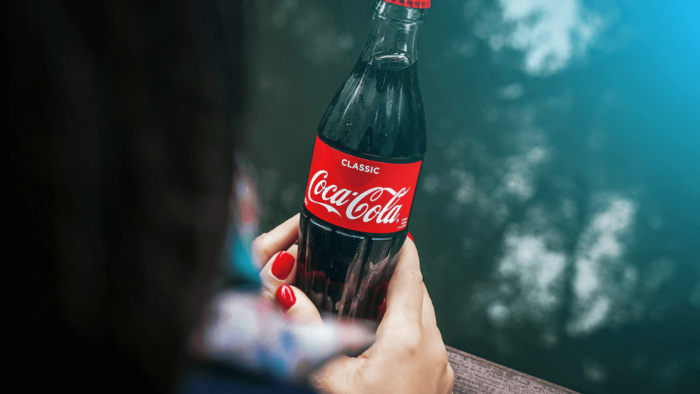Who are you?
What do you believe in?
What makes you different?
No, you’re not starting a life-coaching session – you’re creating your brand identity – the unique way you present your business to your target audience.
But what exactly is a brand identity and how do you create one?
This post will define brand identity and offer 10 pro tips to help you create one that attracts your ideal customer and keeps them coming back for more.
Let’s dig in.
What is Brand Identity?
Brand identity is a collection of visual and non-visual elements – colors, designs, logos, slogans and more – used by a company to convey its image.
An effective brand identity is attractive, memorable, and instantly recognizable. When done well, it helps you differentiate your company from competitors and create a loyal customer base.
Now that you understand the definition of brand identity and why it’s important, let’s get right into some tips for creating a great one.
1. Make it Timeless
What comes to mind when you think about Coca-Cola?
If you grew up in the 90s and it was Christmas time, you might remember a rosy-cheeked Santa Claus on the soda cans or playful polar bears in commercials.
If you grew up decades earlier, you probably remember twisting the aluminum top off their signature curvy bottle with the red and white label.
The point is, Coke’s brand identity is nostalgia for multiple generations.
It’s timeless.
When creating your brand identity, a good question to ask is, will this design stand the test of time?
If you can manage to get multiple generations to associate your imagery with joyful Christmases and hot, fun summers, you’ll create an insanely loyal customer base.
Examples of a Timeless Brand Identity


It’s fierce tagline, “Just do it”, has become a mantra for athletes all over the world.
2. Use Colors Wisely
How do you feel when you see the color blue?
Relaxed? Calm? Thirsty?
How about green?
Earthy? Health-conscious? Or maybe the idea of money comes to mind.
The colors you choose for your brand’s visual identity help convey both the mood and message of your brand.
Colors affect our emotions so strongly, there’s a whole area of scientific study devoted to it – color psychology.
For example, black is used to convey power, sophistication and strength. Think of athletic brands, like Nike and Puma, or cutting-edge tech, like Apple.
The color orange evokes energy, excitement and enthusiasm.
Blue is associated with trustworthiness.
When choosing colors for your brand identity, ask yourself, what do I want my target customer to feel when they see my brand? What adjectives would they use to describe it?
Examples of Colors Within a Brand Identity
Whole Foods Market uses the color green throughout its brand identity to evoke images of nature and to convey eco-friendliness.
Cosmetics brand Clinique uses the color orange in the branding for its perfume, “Happy,” because its fragrance is upbeat, vibrant and citrusy.
3. Be Unique
We live in a world saturated with branding.
If you live in a bigger city, you could see hundreds of brands just by walking the length of one street.
To make sure your brand doesn’t blend into the background, it’s important to create a unique brand identity.
Some ideas for making your brand stand out from the crowd:
Use humor: When you make potential customers laugh, they’ll remember you.
Tell a story: Does your brand have a humanitarian mission? Is there a unique story behind how you created your product? Telling a story will help people emotionally connect to your brand.
Be bold: Edgy brands get noticed. Be brutally honest about how your product works (even if it’s related to bodily functions!) or say something that goes against the grain.
Examples of Unique Brand Identities
Speaking of bodily functions – Dude Wipes takes an edgy and funny angle with its brand identity by speaking bluntly about male personal hygiene.
Dove’s mission is to bring “real beauty” into marketing. They let customers know their photos of women are untouched by photoshop.
4. Be Consistent
Brand identity encompasses much more than a logo and color palette.
Your visual brand assets combine with your messaging (taglines, slogans, mission and value statements) to convey a consistent brand identity across all platforms.
If your visual brand assets are soft, natural and sincere, you won’t want to create a super edgy social media campaign.
If your brand is known for being trustworthy and sophisticated, you won’t be using humor in your messaging any time soon.
Your visual brand identity – your logos, designs, fonts and imaging – should also remain consistent across all mediums. You’ll use these same visual assets for your web design, product packaging and anything else your brand creates.
Examples of Consistent Brand Identities
Old Spice uses its signature bold red color throughout its web design and product packaging. It’s also consistently funny in its taglines and messaging.
Louis Vuitton uses its signature “LV” initials on everything from its handbags to its clothing. The letters have become synonymous with high fashion and luxury.
5. Keep it Relevant
Your brand identity should be relevant to your target customer.
If your target customer cares about the environment, your messaging should reflect that – and your brand identity design might include earthy colors like green or brown.
If your target customer is aged 55+, you’ll use a different brand strategy than you would for the 18-to-25-year-old age range.
To make sure your brand identity matches your client avatar, ask yourself these questions about them:
- How old are they?
- What are their core values?
- What type of lifestyle do they live?
- Are they more masculine or feminine?
- Where do they live in the world?
These are just a few questions to start with – you’ll want to spend plenty of time doing market research, discovering your target customer and making sure your brand identity is in alignment.
Examples of Relevant Brand Identities
Tactical Baby Gear is relevant to young fathers looking for more masculine-looking baby gear.
Underwear brand Tomboy X is relevant to men and women who don’t always conform to gender norms and are body-positive.
6. Simplify
If you’re looking for great brand recognition, simple is best.
Since consumers are bombarded with hundreds of branding images and slogans each day, they’ll find simplicity refreshing and memorable.
A Microsoft study suggests adult attention span has decreased to 8 seconds in 2022 from 12 seconds in 2000 – so you’ve got limited time to let customers know you’ve got what they need.
When creating your brand design and messaging, ask yourself if it’s easy for a busy, distracted consumer to understand and connect with quickly.
If your logo design feels too busy, see if you can simplify it by removing a few elements or colors.
If your messaging or tagline is too long, see if you can say less, and still make an impact.
When you cut through the noise with a strong, simple brand identity, you make life easy for your target customer – and they’ll reward you with their loyalty.
Examples of Simple Brand Identities
Apple uses crisp, stunning images with short, one or two-word sentences to let their cutting-edge products speak for themselves.
Skincare brand The Ordinary differentiates itself among high-end competitors by offering simple, one-ingredient formulas for an affordable cost. Their no-frills packaging and tagline reflect this simplicity.
7. Use High-Quality Images
Part of every marketing strategy is making sure your customers know your product is of the utmost quality.
This is why high-quality images within your brand identity is a must.
Would you trust a brand that featured blurry or irrelevant images in their branding?
Your images should be crisp, clear, and edited by a professional.
But there’s more to it than that – you also need to think about what’s in each image.
Ask yourself:
- Can my target customer recognize and relate to the objects and people in the image?
- If my image is an infographic, is the messaging simple and clear?
- Do the colors make sense?
- Do I own the rights to this image (If it was created by someone else)?
Using high-quality images elevates your brand identity by making it look professional.
Examples of High-Quality Images in Brand Identities
Skincare line Glow Recipe uses bright colors and fresh produce in their photos to draw attention to their plant-based formulas.
Outdoor outfitter Patagonia uses stunning, action-packed photos to display its products.
8. Protect Your Identity
One of the best things about your brand identity is, well, it’s yours.
If you want to keep it that way, you’ll want to trademark it.
The United States Patent and Trademark Office defines a trademark as “any word, phrase, symbol, design, or a combination of these things that identifies your goods or services”.
Your trademark provides legal protection for your brand and guards against fraud and counterfeiting.
The process for applying for a trademark is relatively simple and can be done online.
An important note – a simple trademark will only protect your brand within the geographical area where your business operates. If you want nationwide protection, you’ll need to apply for a registered trademark, which provides broader rights.
Examples of Trademarked Brands
If you look closely, you can see the ® next to the McDonald’s logo, indicating a registered trademark.
Image source: Brand Marketing Blog
Notice the ™in gaming brand EA Sports’ logo.
9. Have a Clear Message
If you want potential customers to understand what your brand offers and what it stands for, you need a clear message.
More importantly, they need to know that your product is for them.
Messaging can include anything from slogans and taglines to company missions and core values.
To make sure your message is clear:
- Keep it simple: Remember, customers have limited time and attention.
- Make it visible: Make sure your messaging is placed where customers can see it – on your website’s home page, packaging and other marketing materials.
- Test it out: Before launching your new branding, test it out on a smaller audience to see if it’s easily understood.
Brand Identities With Clear Messaging
Hair and skincare brand Shea moisture makes it clear that they support the black community and black entrepreneurship.
Delicious Ice cream brand Ben & Jerry’s places their company values on their website, and incorporates them into their tub designs.
10. Evolve Over Time
Just like our personal identities evolve, your brand identity should, too.
What was cool in the 1980s might not be trending in 2022 (Unless your brand is Stranger Things).
To stay relevant to your target customer, you need to update your brand identity and visual assets as time progresses.
Your messaging and mission may also evolve.
For example, surveys show consumers from the Millennial and Gen Z generations care much more deeply about the eco-consciousness of brands than previous generations.
As a result, major brands have stepped up to the plate to voice their plans to help combat social issues like racism, economic inequality, and LGBTQ+ representation.
When you evolve with your target customer, they’ll trust you to provide value over the long term.
Over the last decade, Disney has made an effort to represent more diverse communities and cultures in its stories. Their branding reflects this change.
Image source: 99Designs
To get an idea of visual brand evolution, check out how Apple’s logo has evolved over time.
Which Brand Identity Tip is Your Favorite?
Are you fascinated with color psychology in branding?
Do you have a super unique brand identity you’d love to share?
Have a horror story about failing to trademark your brand?
Let me know in the comments below!
And one of the best ways for you to stand out from the noise of nearly 2 billion websites is through a powerful personal brand! That’s why I’ve put together 13 excellent examples here.
But before you go…
Are you ready to build a business that stands the test of time?
A business that gives you the life you’ve only dreamed of?
Then, you need to discover your True North Business (the one you’re meant to build).
Which is why I want to invite you to my FREE, 60-minute Masterclass — Discover the Business You’re Truly Meant to Build & How to Share It With the World
During our time together, you’ll discover:
- The 7 key criteria to identify the perfect niche for you… so you can make great money AND have the impact you desire
- The 3 questions you need to ask to help you zero in on what’s most important to you so you can design a high-impact, high-profit business you’ll love
- And why you may not have the businesses of your dreams right now and how to tune into what you really want…
Plus, much more!
So, if you’re struggling at all to find your purpose or don’t feel 100% aligned with your business, go ahead and save your seat.






















































Leave a Comment